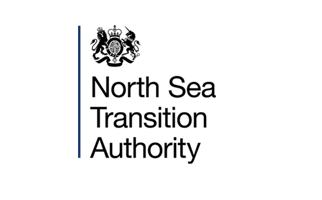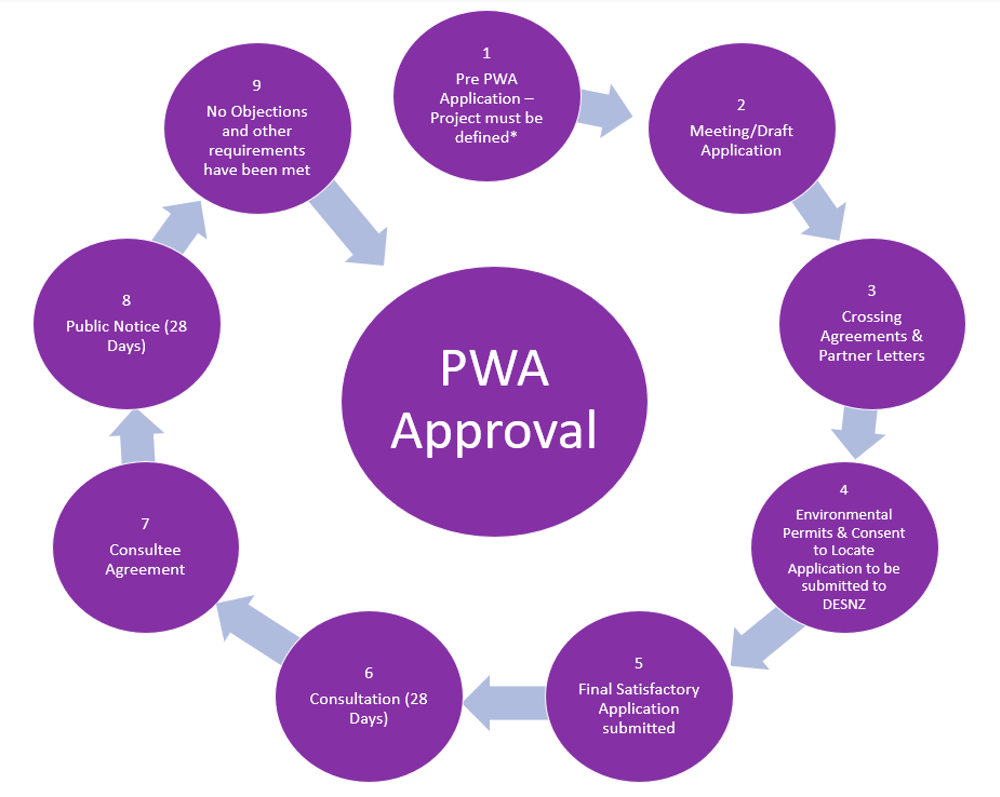

*- Relevant project documents may include Field Development Plan (FDP) for oil and gas, carbon storage permit for CCS, gas storage development plan for natural gas or hydrogen, or interconnector plans.
- At the design stage, companies should make contact with the Health and Safety Executive Specialised Installations Directorate in Aberdeen for Scottish waters, and the Hazardous Installations Directorate in Norwich for English/Welsh waters [see useful addresses] .
- As soon as the route of the pipeline and basic technical details are known, contact should be made with the NSTA consents and authorisations team in Aberdeen to arrange an informal meeting.
- When planning is well under way (e.g., to the extent that it is known whether the pipeline is to be trenched or buried and what type of manifolds are to be used), early contact with local fishing organisations is advised (this gives an opportunity for any problems to be highlighted and hopefully ironed out before the official consultation period.)
- It is important to ensure the application contains all required details (though minor changes may be made at a later stage) and does not contain unnecessary information – particularly in the form of pages of technical drawings.
- The application should be submitted in good time so the PWA may be issued before construction begins (approximately 6 months or longer if the pipeline crosses a median line and there are likely to be treaty issues or where there may be environmental concerns and the possibility of objections is higher).
- Applicants should not hesitate to phone the case officer handling their application if they have any query regarding the content of the application or if they require clarification of the relevant legislation/procedure.
- The holder of the PWA must ensure the terms of the authorisation are upheld and that they make an application well in advance of any proposed modifications/variations and of any changes to the names/addresses of the holder/user(s)/operator and owner(s) for the NSTA’s consideration and possible consent.
- A draft application should be submitted to the NSTA allowing checks and any additional information to be requested from the company prior to full submission and processing of the application.
- The applicant should discuss ‘consent to locate’ requirements with DESNZ's Environmental Management Team (EMT) early in the process. EMT can be contacted at OPRED@Energysecurity.gov.uk. We are unable to issue a PWA consent unless the ‘consent to locate’ consent has also been approved.
- The application will be forwarded to consultees for comment (these are generally the NSTA, DESNZ, or other government departments, fishing federations and other users of the sea). All consults are asked to respond within 28 days.
- When any queries have been answered, and all consultees are content, the NSTA will inform the applicant that they are to proceed to public notice. This requires the applicant to publish and make available for inspection details/maps of the project in such publications and at such addresses as may be directed by the NSTA for a period of 28 days. The applicant should forward the documents to the NSTA for review and agreement, prior to publication.
- Schedule 2 to the Petroleum Act 1998 sets out the procedure for considering any objections to the application.
- Once objections have been resolved or if no comments have been received, the PWA may be issued together with additional ‘consent to locate’ as referred to above. The PWA contains the terms under which the pipelines have been approved, which must be adhered to.
- The NSTA will inform all consultees of the issue of the PWA and arrange publication of a notice to this effect.
Guidance and templates
- Partner agreement, crossing agreement and block crossing letters to be supplied to the NSTA when the initial application is submitted to form part of a satisfactory application
- A Consent to Locate (CTL) should be applied for from DESNZ along with the necessary environmental permits when the initial application is submitted to the NSTA for review. Please discuss environmental permit application requirements with DESNZ EMT (OPRED@Energysecurity.gov.uk)
- On receipt of a satisfactory application; the 28 day consultation period will commence.
- A Public Notice will be published for 28 days only when the 28 day consultation period has concluded successfully.
- When all objections/issues are resolved, or no objections received and other requirements have been met, a PWA Consent may be issued.
- End to end process takes approx. 6 months. Where there are Median Line implications this will be extended to 6+ months.
When a PWA is in place, if there are any changes to Table As then this must be done through a Variation.
- Partner agreement, crossing agreement and block crossing letters to be supplied to the NSTA when the initial application is submitted to form part of a satisfactory application
- A Consent to Locate (CTL) should be applied for from DESNZ along with the necessary environmental permits when the initial application is submitted to the NSTA for review. Please discuss environmental permit application requirements with DESNZ EMT (OPRED@Energysecurity.gov.uk)
- On receipt of a satisfactory application; the 28 day consultation period will commence.
- A Public Notice will be published for 28 days only when the 28 day consultation period has concluded successfully.
- When all objections/issues are resolved, or no objections received and other requirements have been met, a PWA Consent may be issued.
- End to end process takes approx. 6 months. Where there are Median Line implications this will be extended to 6+ months.
When a PWA is in place, if there are any changes to Table As then this must be done through a Variation.
Installation or Variation Where any pipeline is less than 500m in length or totally within a HSE recognised safety zone or varying an existing pipeline in the PWA Regime.
Removal or Out of Use Where an existing pipeline within the PWA Regime is to be partially or fully removed from the seabed or taken out of use. This is prior to agreement of COP.
- On receipt of a satisfactory application; the 28 day consultation period will commence.
- When all approvals are received from the consultees and the necessary environmental permits are in place a PWA Variation Consent may be issued.
- End to end process takes approx. 8 weeks. Where there are Median Line implications this will be extended to 8+ weeks.
In accordance with Term 16 of the PWA the Holder is to notify consents@nstauthority.co.uk of proposed modifications/variations and of any changes to the names or addresses of the holder, user(s), operator and owner(s).
Where a Licence transfer is taking place, you must apply 8 weeks in advance of the proposed transaction date. Please note upon transaction completion the process can take up to 90 days to execute. No consent will be considered until this occurs.
The permanent placing or deposition of material for the support or protection of a pipeline e.g. gravel, rock, mattresses or protective pipeline covers, on the seabed during the construction of a pipeline is governed by the Pipeline Works Authorisation. Schedule 2 of the authorisation prohibits any further deposition except with the prior written consent of the NSTA. In instances where, as part of a project requiring a PWA/PWA variation/deposit consent, materials are to be deposited on a temporary basis, please supply a list of the temporary deposits including the following information:
- the type of deposit
- how long it will be on the seabed
- whether the deposit will be within or outside a 500m safety zone.
Please note: this is for our information only and applications for temporary deposits should still be directed to the DESNZ Environmental Management Team for consideration.
For pipelines that do not have a PWA, e.g. pipelines constructed prior to the coming into force of the Petroleum and Submarine Pipelines Act 1975, any deposition would require a licence under the Marine and Coastal Access Act 2009. However, by virtue of the Petroleum Act 1998 (Specified Pipelines) Order 2011, operators have the option of applying for a PWA for those existing pipelines that were consented before the Petroleum and Submarine Act 1975, therefore precluding the requirement for an MCAA license.
It would be worth noting that there may be other circumstances where the operator may choose to apply for an MCAA License for specific activities in advance of seeking approval under the Petroleum Act (PWA) regime. MCAA licensable activities are likely to be primarily related to decommissioning operations, which are not activities exempt under the MCAA regime. Advice should be sought from consents@nstauthority.co.uk or DESNZ EMT.
Applications should be submitted 8 weeks in advance of any proposed work scopes.
Where the problem with a pipeline(s) may not be clearly identified and there may be various points of possible failure, NSTA may consider an Options case. Options are not to be used as a substitute for surveying and investigating a problem. Where there are problems with pipelines, the operator should have thoroughly surveyed and investigated the fault or situation.
Should you be required to apply for an Options application please provide a brief summary outlining the work scope and reasons for an Options requirement via email to consents@nstauthority.co.uk. A copy of the agreement email to use an Options application should be attached as a pdf in the portal application.
If you are applying for an Options application on the new PWA system please use the following template accessed here. This should be completed and uploaded to the new system, but only once prior agreement to use an Options has been granted with the Consents and Authorisations Manager.
Where you report back to the NSTA that the works have been carried out as per a stated Option, you must then update the HUOO, pipeline details and schematics before passing this back for review to the Case Officer. This must be done no later than 5 working days after final date of completion, as stated in your application.
- A maximum of a 6 month period may be requested to complete works and any testing. If a longer term is required, please provide justification within the initial email for the longer period.
- If Options works have not commenced within the agreed time period, the case will be closed, and the Holder will have to reapply.
When a PWA is in place, if there are any changes to Table As with regards to Decommissioning subsea pipelines then this must be done through a Variation.
On 1st November 2022, the NSTA retired the Cessation of Production (CoP) Process. Licensees will no longer be required to complete and submit a COP report. The Decommissioning template is to be used on the condition that the operator has confirmed the last day of production in writing to NSTA Operations.
Please refer to the decommissioning template advice to industry document for specific NSTA guidance and recommendations on preparing variation application(s) for Decommissioning subsea pipelines.
The NSTA recommends an initial kick off meeting is to be held a year in advance of proposed pipeline works.
- On receipt of a satisfactory application; the 28 day consultation period will commence.
- When all approvals are received from the consultee and the necessary environmental permits are in place a PWA Variation Consent may be issued.
- End to end process takes approx. 6 months from receipt of a satisfactory application. Where there are Median Line implications this will be extended to 6+ months.
Draft Letter Templates
The draft letter templates below are for Block, Cable, Pipeline and Partner Letters. The final signed letters must be uploaded within the application. Draft letters can be accessed here.
Definitions
Under Part 3 of the Petroleum Act 1998 an authorisation is required for the construction and/or use of a “pipeline” in “controlled waters”. For these purposes, controlled waters means the territorial sea adjacent to the UK and the sea in any area designated under section 1(7) of the Continental Shelf Act 1964.
The Energy Act 2008 defines pipelines as a “pipe or system of pipes (excluding a drain or sewer) for the conveyance of anything, together with all apparatus, works and services associated with the operation of such a pipe or system”. This includes pipelines used for the conveyance of hydrocarbons, water, chemicals, apparatus for the supply of energy for operations, hydraulic control lines or umbilicals, as well as services (for example the provision of fuel or power).
Additional approvals and consents under The Offshore Petroleum Production and Pipe-lines (Assessment of Environmental Effects) Regulations 1999 (As amended), The Offshore Petroleum Activities (Conservation of Habitats) Regulations 2001 (As amended) and Part 4a of the Energy Act 2008 will also be required for their construction/use.
With the introduction of the Marine and Coastal Access Act 2009 (MCAA) the following should also be noted:
- the construction of pipelines in internal waters will require a Marine Licence and operators should seek advice from the consents team or DESNZ EMT as requirements may differ between devolved authorities and dependent on whether the pipeline is associated with oil and gas, carbon capture and storage or gas unloading and storage activities.
- the MCAA (2009) provides an order-making power by which the Secretary of State may provide that the provisions of Part 3 of the Petroleum Act 1998 do not apply to a specific pipeline or pipelines of a specified description.
- in addition, the MCAA (2009) provides a second order-making power which allows DESNZ to provide that Part 3 of the Petroleum Act applies to specified pipelines or to pipelines of a specified description where the pipeline is used in connection with exploration for, or exploitation of, petroleum, or the importation of petroleum into the UK and that by virtue of the date when construction of the pipeline was begun, section 14(1)(b) of the Petroleum Act 1998 would not apply in relation its use.
Under the Petroleum Act 1998 a “works authorisation” means an authorisation:
- for the works for the construction of a pipeline
- for such works and for the use of the pipeline
The person to whom the authorisation is issued. An authorisation may not be issued to a person other than a body corporate.
The person(s) authorised by the PWA to use the pipeline for the purpose of conveying any fluid, or other, so authorised.
The person designated by the holder as responsible for organising or supervising the construction or operation of the authorised pipeline in a manner that complies with the authorisation and, inter alia, with any relevant legislation existing at the material time. The works authorisation may name the operator as the holder.
The person(s) in whom the pipeline is vested; and a person who has the right to use capacity in the pipeline, where such right has been acquired by that person on terms that – (a) he is entitled to use the capacity for a period of one year or more, and (b) the right is capable of being assigned or otherwise disposed of to another person. The Petroleum Act 1998 allows the NSTA to make an order, designating a person as the “owner” of a pipeline, after giving the person concerned an opportunity of being heard on the subject.
Required before any material >e.g. rocks/mattresses are placed on the seabed for the protection or support of a pipeline during construction or maintenance of a pipeline. A PWA must be in place before any Deposit Consent can be issued.
Like for Like replacements
If you are proposing to carry out works on a section of pipeline and replacing this with a like for like piece of infrastructure or component, please contact the Consents team via email (consents@nstauthority.co.uk) confirming the following information:
- Provide a high-level overview of the works to be carried out (including pipeline number(s) and PWA reference(s));
- If there any change to the existing Table A?;
- Are the like for like replacement works on a previously un-numbered pipeline?;
- Are there associated environmental permits required from DESNZ for the pipeline works? (Provide response from DESNZ) and;
- If the works are being carried out on a MAH pipeline, have the HSE been informed of the change?
The Consents team will issue advice based on the information provided. Each case will be treated on its own merit, decision on a way forward will be decided on a case-by-case basis.


